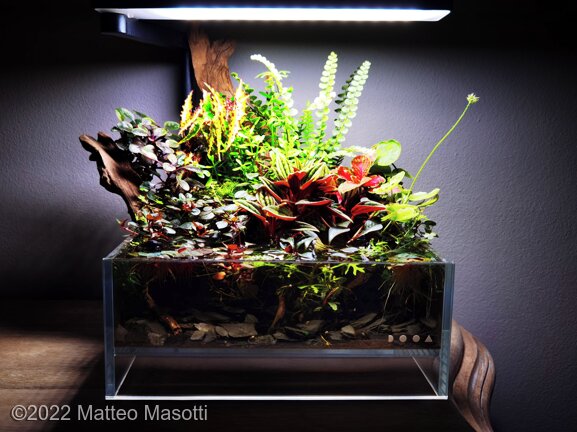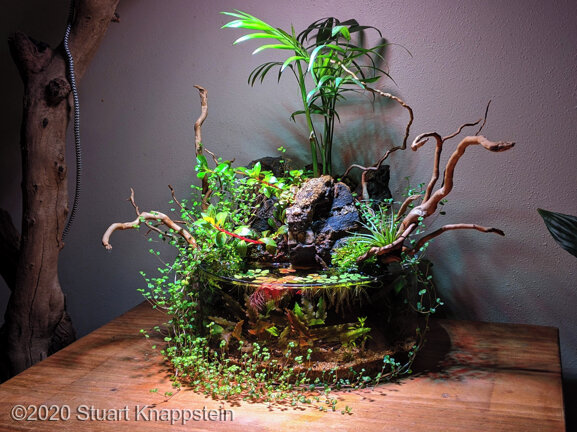
Rules and Guidelines
Table of Contents
- some general information about entering the aquascaping contest
- details on how the aquascapes are judged
- rules on photographs and planting plans
- specific rules for each category:
- Aquatic Garden (normal aquascapes)
- Biotope Aquascape
- Dutch Aquascape
- Paludarium rule change for 2023!
- Wabi-Kusa rule change for 2023!
- Riparium new category for 2023!
Please read these guidelines before entering the contest. You may also wish to read the Frequently-Asked Questions.
General Entrance Guidelines
The AGA Aquascaping Contest is open for entry for 2-3 months in the latter half of the year, with results announced a few months later. Please check the showcase home for the exact dates for this year.
This event is primarily a friendly way for hobbyists to share their aquascaping efforts with each other, and to learn better techniques through the display and evaluation of those efforts. The contest will also allow hobbyists to compete for awards. The event is open to all hobbyists, regardless of age, national origin or degree of experience in the hobby.
The primary focus of the event is on Aquascaping in freshwater aquaria. Brackish and Marine aquaria will be acceptable in the Biotope category only.
Each aquascape is entered and judged in one (and only one) of the following categories: Aquatic Garden, Dutch Aquascape, Biotope Aquascape, Paludarium, Wabi-Kusa, and Riparium.
All but one of the categories require that the aquascaper use live plants in their aquascape. The Biotope Aquascape category is reserved for aquariums that are attempting to recreate a particular natural environment, and as such will be judged accordingly. Biotopes may or may not include plants, but should be made of primarily natural materials.
Each aquascaper will need to:
- Complete a form with a small amount of personal information (including their real legal name, City and Country)
- Agree to the photo release (part of the above form)
- Supply basic information for each aquascape (maximum three aquascapes per aquascaper)
- Upload photographs (1-5 per aquascape)
A maximum of three (3) aquascapes may be entered per year per aquascaper, regardless of category. Attempts to enter more than three aquascapes using multiple accounts will result in immediate disqualification of all aquascapes.
new for 2023! Only one aquascape per physical aquarium is allowed. This means that if you changed the same aquarium multiple times, whether it be a full re-scape, or just a single plant change, you may only submit one aquascape from that aquarium this year.
new for 2023! The aquascape dimensions should be reported from the bottom of the aquarium up to the water line. So, for example, a 60cm W × 40cm D × 40cm H would have a volume of 96L, but if it is only filled to 30cm, then it should be reported as 60cm × 40cm × 30cm and its volume as 72L. For aquariums with non-square dimensions, make your best approximation.
new for 2023! Aquascapes need not have been created in the past year. However, if you have already entered the aquascape in a previous AGA contest, then new photographs taken in the last year must be used. Disqualified aquascapes may not be re-entered in subsequent years.
Aquascapers are forbidden to ask advice or show aquascape photos to members of the AGA Board of Directors or current contest judges. The first offense will result in a warning, and the second offense can result in disqualification of the aquascape. Continued attempts to contact the members of the AGA Board of Directors or judges will be considered an attempt to influence the aquascape's score and will result in banning the aquascaper from the contest for that calendar year.
Aquascapers are asked to not include personal identifying
information in the aquascape text fields and photographs. The one exception is a
special No-Judge Notes
field, which can be used for additional
text hidden from the judges but seen by the public later.
The contest committee reserves the right to remove any inappropriate identifying information.
Further questions may be answered by the organizers at showcase@aquatic-gardeners.org
Judging and Awards
Judging will be conducted with each aquascape identified only by a number; i.e., the judges will not know the identity of the person whose aquascape they are considering. Judges do not communicate with each other when scoring each aquascape.
Within each category, each judge's ranking (not raw score) for the aquascapes
will
be harmonically
averaged to determine the overall placing of
aquascapes within the category. Awards (1st, 2nd and 3rd place)
will be given to the three highest placed aquascapes. Overall
placings 4~10 be acknowledged as "top ten" (presented in aquarium
volume order, not placing order!). There is no monetary or physical award for
top ten; it is a bragging rights
award only.
After the winners are tabulated, the judges will also choose, by
vote, a Best of Show
Aquascape from the Aquatic Garden categories, and a Most Innovative
Aquascape from all categories. They will communicate with
each other over this decision.
Judges are asked provide feedback on the qualities of each aquascape in the contest. These comments will be placed on the website associated with the appropriate aquascapes. After the winners are announced, judges may be available (at their discretion) on the AGA Facebook group where aquascapers can post a photo and request commentary.
The decisions of the judges are final.
Photographs
The short version:
- 1-5 Photos
- Highest Resolution Possible
- Limited editing only; no
cloning
, compositing, smudging, or other effects. - Camera original image must also be provided.
- No identifying
burn-ins
- No borders or frames, please
- No collages (multiple photos in same image)
- No photos of people or 'selfies'
The aquascaper is requested to provide 1 ~ 5 images of each aquascape, ideally showing both overall views and close-ups of details they wish to highlight.
While the focus of this event is on the aquascape shown in the images, the aquascaper is encouraged to try and provide the clearest, sharpest images possible. The better the images that are provided, the better they will reproduce and display. The website currently only accepts JPEG images, but there is no size or quality limit.
The aquascaper may alter an image only for color correction, lens and distortion correction, rotation, brightness, shadow/highlight,
contrast and/or sharpness. HDR
filtering is also permitted.
Any modification that effectively alters the content of original image is grounds for immediate disqualification. Such alterations include, but are not limited to:
cloning
elements of the image to remove an imperfection or improve the appearance (eg., retouching out a snail or a piece of algae).- Selectively compositing multiple images to improve the overall image (eg., creating a 'perfect' school of fish from parts of different photographs).
- Selectively
coloring
areas of the aquascape with a transparent solid color to artificially enhance the color of plants. - Selectively
blacking out
the background to hide equipment or other flaws.
In order for the contest to be fair to all aquascapers, we require the upload of the camera original of the main photograph. The camera original will not be seen by the judges, only used to verify the authenticity of the final image. All aquascapers not submitting the camera original are subject to disqualification.
Many aquascapers feel the need to add large frame
borders around
their photographs; this detracts from the image, by making it scale
smaller than others. In all likelihood, we will just remove
the border. Please save us the work, and submit all images
borderless.
Images submitted should not have the photographer's name or Copyright Notice
superimposed over the image. Images should not include the aquascaper or other people in the picture (aka, a selfie
).
Judging needs to be anonymous, and this information could
affect the impartial evaluation of aquascapes. We will add a copyright 'burn-in' in the final website.
When creating a planting plan, keep in mind that a blocky diagram works much better than something with thin lines, and high-resolution graphic is just as important as in the photographs. A simple sketch with a Sharpie pen on a piece of paper will look better on the final site than a bad MS-Paint graphic.
All aquascapers must agree to a Photo Release before their aquascapes will be accepted into the contest.
Aquatic Garden Categories
The vast majority of the aquascapes are entered in the Aquatic Garden categories. If the aquascaper is unsure which category is correct, it is very likely Aquatic Garden.
The Aquatic Garden category is further sub-divided by aquarium volume. The choice of how many divisions and precisely where the splits occur is based on participation and is up to the discretion of the judges and organizers.
Aquatic Garden Judging Breakdown
- Overall Impression - maximum 70 points
- Does the aquascape make a significant positive visual impression upon the viewer?
- Do all parts of the aquascape work together to present a harmonious whole?
- Composition, Balance, Use of Space, Use of Color - maximum 60 points
- Is the aquascape layed out well?
- Does balance exist between the various components of the aquascape? Is space within the aquarium used effectively? Do open areas exist and balance and complement more enclosed spaces?
- Are the colors of the various elements of the aquascape (including animals) complementary and do they work well together?
- Selection and Use of Materials - maximum 40 points
- Are the materials selected for use within the aquascape appropriate for use in an aquarium?
- Are the various materials harmonious with one another? I.e. if several rocks and/or pieces of driftwood are used, do they compliment one another or do they produce a discordant effect?
- Do the animals compliment or detract from the selection and arrangement of hardscape and plants?
- Viability of Aquascape - maximum 30 points
- Is the aquascape set up in a manner which, with proper maintenance, is likely to lead to long term (one year or more) success of the aquarium?
- If used, are the plants selected for the aquascape appropriate for long term use in an aquarium?
- Are the animals selected as inhabitants of the tank likely to cause damage to one another or to the aquascape itself? Are the animals appropriate to the size of the tank that houses them?
Biotope Aquascape
A biotope is a habitat originating from a specific location. It has particular environmental characteristics specific to the area and a native population of plants and animals. A single stream or lake may include numerous biotopes. For instance, a stony riffle in a stream may be one biotope while a nearby silt-bottomed pool on the same stream may be a different biotope. On the other hand, the same biotope may occur in numerous streams in a region where all stony riffles or silt-bottomed pools support the same community of plants and animals.
In its purest form, the biotope aquascape is a microscopic representation of a naturally-occurring particular geographical area in the wild.
An aquascape that accurately represents a biotope through species selection and arrangement of hardscape and living elements will receive a higher score.
Biotope Pre-selection Requirements
- Material used (including wood, rocks, and other hardscape) should, as closely as possible, represent the appearance of natural materials found in the specific location.
Example: Mopani driftwood would not be used in an Asian rainforest biotope aquascape. However, manzanita wood could be used effectively to represent branches and roots in an Amazon biotope. -
Plants and animals should be indigenous to the specific location.
Example: Guppies should not be used in a Lake Malawi biotope aquascape. However, a few non-native fish or shrimp included for algae control will be overlooked. - Choice and placement of plant and animal species should also represent the specific location.
Example: Although both plants grow in Asian streams, it would be unlikely to find Cryptocoryne cordata, which likes shaded areas, mixed with C. crispatula, which is found in sunny areas. - Exotic, non-native, or invasive species of plants and fish should not be used in a biotope aquascape. All flora and fauna should be native species originally indigenous to the biotope being described.
- Aquascaping methods used for Aquatic Garden aquariums are not applicable to biotope aquascaping. Design should be directed toward creating an authentic replication of a natural habitat. Arrangement of hardscape materials, and placement and grouping of plants, should mimic that found in nature rather than an abstracted image of a natural scene often used in Aquatic Garden aquascaping.
- Salt marsh/marine planted aquaria are acceptable in the Biotope Category only. Plants/macroalgae should be the majority
plant
. Corals and other sessile inverts, if any, should be minimal. - We do not condone the use of flora, fauna and materials that are collected from protected environments. If we find that an entrant has done this, their aquascape will be disqualified.
An expert committee will screen submissions in the Biotope Category and accept those aquascapes that in its sole determination, follow these rules. The committee’s judgment will be final. If there are questions regarding the validity of the biotope aquascape, the committee may ask for justification.
Based on the criteria, to aid the screening process, we strongly suggest that the aquascaper provides the following information:
- A description of the biotope represented by the aquascape.
- A description of the materials used in the aquascape, including plants, fish, and hardscape materials. Include why certain choices were made.
- References to substantiate the appropriateness of the materials used. Books, articles, photos, and web links are all acceptable references.
If the committee rejects a submission because it does not meet the Biotope guidelines, the AGA will automatically disqualify the aquascape.
Biotope Judging Breakdown:
After a Biotope aquascape has been approved by the screening committee, it will be judged by the AGA International Aquascaping Contest judging panel. Each judge will score the biotope based on the following criteria:
- General impressions/ faithful reproduction of biotope - maximum 70 points
- Accuracy of plants and animals for biotope - maximum 60 points
- Accuracy of hardscape - maximum 40 points
- Condition - maximum 30 points
Dutch Category Judging Guidelines
Vin Kutty has written a quick style guide for beginners that will help clarify what is (and is not) Dutch Style.
Overall Impression - maximum 50 points
- Does the aquarium as a whole; plants, fish, and hardscape, create a positive visual impact?
- Do all parts of the aquarium work together to present a harmonious and cohesive whole?
- Do the plants and animals appear healthy?
- No hardware should be visible.
Composition: Balance, Use of Space, Use of Color - maximum 60 points
- Is the aquascape layed out well?
- Does the aquarist make effective use of the “Rule of Thirds” to create (a) focal point(s)? (Tanks 36” or less in length should not have more than one focal point.)
- Are the plants well grouped, and are the groups well defined? (Traditional NBAT rules dictate a small space between groups)
- Does the aquarist make good use of differences in color, leaf size and shape, and height (growth habit or trimming) to maximize contrast between groups of plants? (Groups of neighboring plants should clearly be of different heights)
- Does the aquarist effectively use differences in height and plant group shape to create a sense of flow and depth?
- Is there a plant “street”? If so, is it easily discerned and does it enhance the sense of depth of the aquascape?
- Are the back and sides are planted? Do the species and planting enhance or detract from the sense of depth and scale? (Traditional NBAT rules dictate the portion of the walls not covered by species in the substrate be planted.)
Selection & Use of Plants, Hardscape Materials, and Animals - maximum 50 points
- Has the aquarist selected plants appropriately?
- Traditional NBAT rules dictate use of no more than 1 plant species per 10 cm/4 inches of tank length (sometimes up to 2 more species per tank if their use doesn't detract from the aquascape; judge's discretion). Has the aquarist effectively used a limited number of species?
- If a Specimen Plant is used as a focal point, does it blend well with the aquascape or is it overpowering? i.e., does it draw and hold the eye too strongly or is it simply too large?
- Do the colors, shape, and size of the fish chosen harmonize with the plants?
- Are schooling fish present in sufficient numbers to make a suitable school? (Traditional NBAT rules dictate at least 12 fish per schooling species)
- If hardscape materials are present, are they used sparingly as a stand alone element? (A single piece of wood or a rock may be acceptable according to NBAT rules if it enhances the aquascape. Wood and/or rocks used as structure and mostly covered by epiphytes does not count.)
- Are planted sides and rear panes present or absent? There should be no visible glass except for the front viewing pane. (This criteria only addresses the presence/absence of planted walls as a hardscape/design element for clarity. If planted walls are not present or if glass is visible deduct points. Use of walls should be considered as part of Composition.)
Viability of Aquascape - maximum 40 points
- With appropriate grooming and maintenance, are the plants selected suitable for use in the aquarium if maintained as-is for a long period?
- If visible, are the fish and other animals likely to be too large for the aquarium, cause damage to the aquascape, or each other at adult size?
Paludarium
Criteria required for consideration as a Paludarium: rule change for 2023!
- Water portion of the aquascape must have a fully developed planted section. An image of the hardscape prior to planting is highly encouraged for the contest.
- If fauna is part of the aquascape, it should be appropriate for the aquascape, and the water portion suitable to maintain health of the fauna.
- The entire paludarium must be fully or partially enclosed by glass, as opposed to the Riparium (Pond Aquascape), which must only be enclosed on the bottom.
- Water portion of the paludarium must only include aquatic plants in submersed form (i.e., plants cannot appear to be emersed grown and flooded prior to photographing). It is acceptable for plants to grow from submersed to emersed naturally along the bank.
Paludarium Judging Breakdown:
- Overall Impression - maximum 50 points
- Does the aquascape make a significant positive visual impression upon the viewer?
- Do all parts of the aquascape work together to present a harmonious whole?
- Properly constructed Paludarium (Maximum Score 70 points)
- Is a significant amount of the display devoted to water and is it well developed and well planted part of the whole design? This does not need to be 50/50 or even 25/75, as different tank sizes and shapes will dictate different ratios. But neither the land nor the water should be treated as a superficial “add on” or “feature”. Both MUST be a well developed and well planted part of the whole design. (Sub-Score 30 points)
- Is a significant amount of the display devoted to land and is it well developed and well planted part of the whole design? This does not need to be 50/50 or even 25/75, as different tank sizes and shapes will dictate different ratios. But neither the land nor the water should be treated as a superficial “add on” or “feature”. Both must be a well developed and well planted part of the whole design. (Sub-Score 30 points)
- Is the entire paludarium layed out well? Does the land flow naturally into the water? (Sub-score 10 points)
- Composition, Balance, Use of Space, and Color, Selection and Use of Materials - maximum 50 points
- Does balance exist between the various components of the 'scape? Is space within the aquarium used effectively? Do open areas exist and do they balance and complement more enclosed spaces?
- Are the colors of the various elements of the paludarium (including animals) complementary and do they work well together?
- Are the materials selected for use within the aquascape appropriate for use in a paludarium? While it is common to use artificial materials when building a paludarium, are they well-hidden so as not to distract from the display?
- Are the various materials harmonious with one another? I.e. if several rocks and/or pieces of driftwood are used, do they compliment one another or do they produce a discordant effect?
- Do the animals compliment or detract from the selection and arrangement of hardscape and plants? The paludarium planting should be well developed above and below water. Whether to include animals is up to the aquascaper, though beautiful, appropriate species can never hurt a display!
- Viability of the Paludarium Aquascape - maximum 30 points
- Paludariums should never be a short-term arrangement like an aquascaped aquarium. Therefore, the ability to maintain a paludarium for a length of time is to be encouraged. Is the paludarium set up in a manner which, with proper maintenance, is likely to lead to long term (one year or more) success of the paludarium?
- Are the plants selected for the paludarium appropriate for long term use in the land or water portion as they are used? Are the plants chosen likely to over-run the enclosure, or will animals be too large at their adult size?
- Are the animals selected as inhabitants of the tank likely to cause damage to one another or to the paludarium itself? Are the animals appropriate to the size of the tank that houses them?
Some Paludarium Examples
Note how the paludariums shown are fully or mostly enclosed:
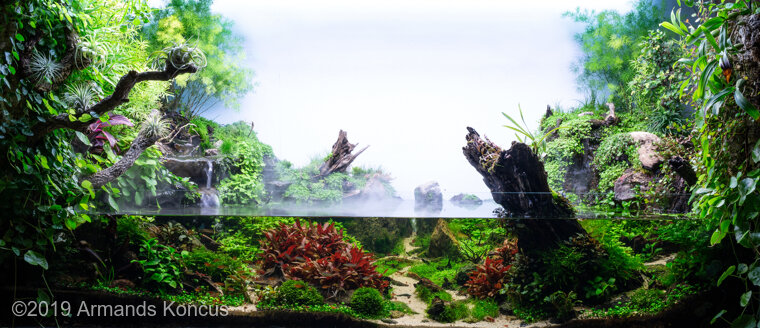
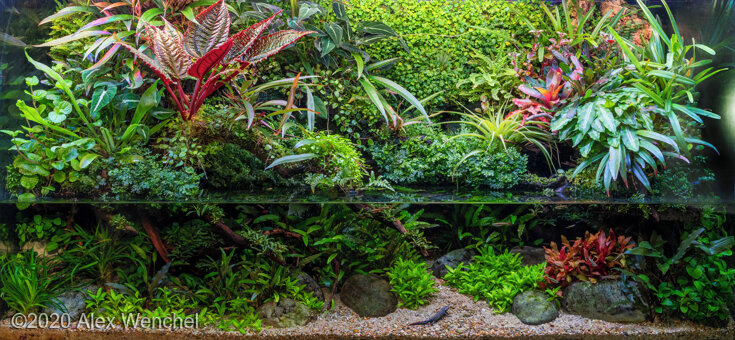
Wabi-Kusa
For the purposes of this contest, a Wabi Kusa is a ball of compressed substrate that has been developed into an artistic interpretation of aquatic plants that are not contained by their vessel, but by a substrate ball from where plants can freely grow.
- updated for 2023! A photo clearly showing the Wabi Kusa substrate ball must be included for the aquascape to be considered valid in the category.
- updated for 2023! A photo showing the water portion must be included for the aquascape to be considered valid in the category.
- The Wabi Kusa must not include any terrestrial plants. All plants used must be aquatic plants that can be normally grown submersed and used in an aquarium. Use of marginal pond plants or terrarium/vivarium plants will result in immediate disqualification of the entry.
Wabi Kusa Judging beakdown:
- Health and Condition - maximum 100 points
- Is the layout healthy and free from any undesirable elements? (40 points)
- Are the aquatic plants healthy and appropriate for the aquascape? Aquascapes featuring any terrestrial-only plants will be summarily disqualified. (40 points)
- Is the water portion clean and clear? Layouts without a water feature will be summarily disqualified. (20 points)
- Artistic Skill, Impression, and Creativity - maximum 100 points
- Does the layout demonstrate artistic skill through the use of arrangement, colors, textures, and hardscape? (40 points)
- Is the layout especially creative or impactful? (40 points)
- Do any other elements of the Wabi Kusa (such as the vessel and light chosen for display, etc.) add to or detract from the impression? (20 points)
Wabi Kusa Example
Note the supplemental photo showing the required substrate ball.

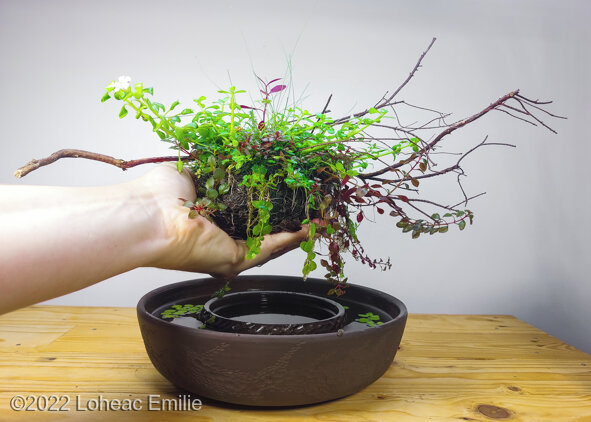
Riparium
New for 2023! A Riparium is described as a riverbank or shoreline aquascape incorporating both paludarium and Wabi Kusa elements, but without the restrictions of having the entire display enclosed in glass; only the bottom portion must be enclosed. The riparium allows for the use of both aquatic and terrestrial plants and does not require the use of a substrate ball combining the traits of both types of aquascapes. For the riparium, there is not a requirement for a dedicated and developed land area and plants can be grown attached to wood and stone in and out of the water.
Like the Wabi Kusa and the Paludarium category, the riparium does require a water portion like the other categories but does not require plants be grown in a substrate ball like the Wabi Kusa aquascapes.
A water portion must be visible, like a Wabi Kusa entry, but is not limited in depth.
Riparium Judging Breakdown:
- Overall Impression - maximum 50 points
- Does the aquascape make a significant positive visual impression upon the viewer?
- Do all parts of the aquascape work together to present a harmonious whole?
- Well developed emersed portion of the Riparium
- maximum 45 points
Is the emersed area well developed with the use of hardscape and a good use of plants? Plants can be be terrestrial, epiphytic and/or the emersed form of aquatic plants, but preference should be for 'scapes including the use of some aquatic plants. - Well developed water section of the Riparium
- maximum 25 points
While the Riparium is not a Paludarium, and is not expected to have a fully developed planted water section, the water area should be an integral part of the display, not just a container of water that the terrestrial display is set in. Although the points awarded for this section are less, they can make or break a winning display and should not be overlooked.- Is the hardscape below the water integrated with that above the water?
- Are aquatic plants included in the water section? (Not a requirement, but if well-used, will boost score)
- Is the water section an attractive addition to the display?
- Composition, Balance, Use of Space, and Color Selection and Use of Materials - maximum 50 points
- Does balance exist between the various components of the 'scape? Is space within the display used effectively? Do open areas exist and do they balance and complement more enclosed spaces?
- Are the colors of the various elements of the riparium (including animals, if any) complementary and do they work well together?
- Are the materials selected for use within the ‘scape appropriate for use in a riparium? While it is common to use artificial materials when constructing a riparium, are they well-hidden so as not to distract from the display?
- Are the various materials harmonious with one another? I.e. if several rocks and/or pieces of driftwood are used, do they complement one another or do they produce a discordant effect?
- Do the animals (if any) complement or detract from the selection and arrangement of hardscape and plants? The riparium planting should be well developed. Plants grown below the water should be appropriate to that area, and growing; not look like they were just placed there for a photo shoot. Whether to include animals is up to the aquascaper, though beautiful species appropriate to the size of the display can never hurt!
- Viability of the Riparium - maximum 30 points
- Ripariums should never be a short-term arrangement like an aquascaped aquarium. Therefore, the ability to maintain a Riparium for a length of time is to be encouraged. Is the Riparium set up in a manner which, with proper maintenance, is likely to lead to long term (one year or more) success of the Riparium?
- Are the plants selected for the Riparium appropriate for long term use in the land or water portion as they are used? Are the plants chosen likely to over-run the enclosure, or will animals be too large at their adult size?
- Are the animals selected as inhabitants of the tank likely to cause damage to one another or to the riparium itself? Are the animals appropriate to the size of the enclosure that houses them?
Some Riparium Examples
Here are two examples that were disqualified as Paludarium or Wabi Kusa in previous contests but which would do well in the Riparium category. Note the visible presence of water in a vessel that does not enclose the entire aquascape.
